
2 minute read
DAY
from Sugarbeet May 2022
by agweek

BY JEFF BEACH
“I like to try new things,” Vance Johnson says.
This summer, sugarbeet growers and others will get a chance for an up-close look at some of his experiments with a test plot just north of Breckenridge.
Last year was the first year of the 60-acre test plot with corn planted into what had been a wheat field the year before.
This year, Johnson is following the corn with sugarbeets, and his field will be the site of a demonstration day on July 13.
“Sugarbeets into corn — I don’t know what that’s going to look like,” says Kim Melton, with the Wilkin County Soil and Water Conservation District, who is working with Johnson on the site. She says she doesn’t know anyone else who follows corn with sugarbeets, but Johnson says he has done it routinely.
He also had experimented with reduced tillage farming and cover crops, some other aspects of the test plot.
The field is cut into three strips: conventional tillage, strip-till and no-till. Each of the three strips is cut in half again, with one half seed with cover crops and the other half without.
“The most challenging is going to be sugarbeets into the no-till,” Johnson says.


But like Melton, he is curious about what the crop residue will mean for soil health and yields.
“I’m going into it knowing what kind of problems I could have,” he says.
The test plot is just north of Breckenridge at the corner of U.S. Highway 75 and Wilkin County Road 16.
Melton said she was looking for a test plot a couple of years ago and was looking for a site with high visibility and easy access.
Shortly after telling Johnson about her wish, he told her he had the perfect site, just north of the Breckenridge hospital.
Before long she had a long list of sponsors, including the Minn-Dak Farmers Cooperative, Agassiz Seed and Supply to supply the cover crop seed, and Wilbur Ellis to fly it on.
For the first demonstration day in July 2021, there were speakers from the Minnesota Department of Agriculture and Natural Resources Conservation Service. Melton said more than 70 farmers from three states attended.

The Minnesota Department of Agriculture is supplying soil moisture and temperature probes for the different strips among other data being collected.

Johnson volunteered the use of the field for five years, in part to satisfy his own curiosity. The sugarbeets will be followed by corn, then soybeans and back to spring wheat.
He said there was a subtle improvement in the corn with the cover crop.
Johnson is keeping track of the economics of the experiments to know what practices might stick in the Red River Valley.
Details on this year’s demonstration day are yet to be announced but it will start in the morning with speakers, including Johnson, with lunch available.
“It’s teaching us a lot about farming these clays in the valley,” Melton said of the site. “Our soils are so different from anywhere else in Minnesota.”









